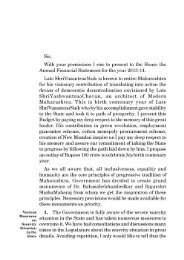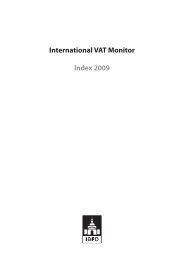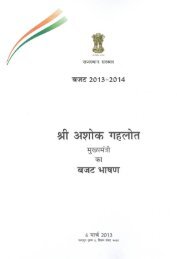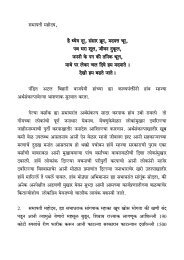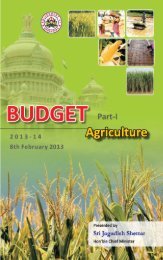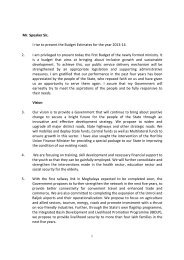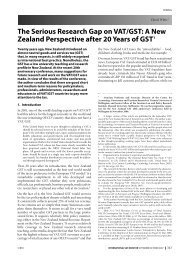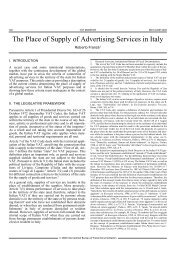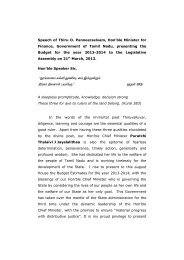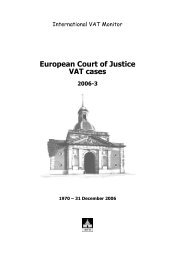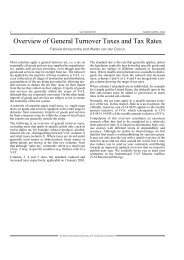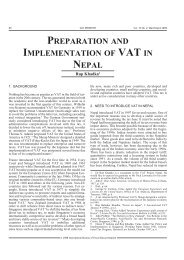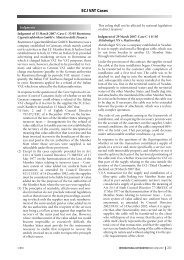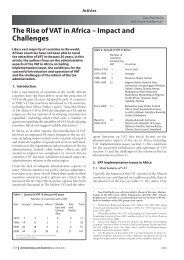The New EU Place-of-Supply Rules from a ... - empcom.gov.in
The New EU Place-of-Supply Rules from a ... - empcom.gov.in
The New EU Place-of-Supply Rules from a ... - empcom.gov.in
Create successful ePaper yourself
Turn your PDF publications into a flip-book with our unique Google optimized e-Paper software.
Articles<br />
which differ substantially. For example, depend<strong>in</strong>g on<br />
the Member State:<br />
– f<strong>in</strong>ance lease may be treated as a supply <strong>of</strong> goods or<br />
services (see 2.);<br />
– sale-and-lease-back transactions may be treated as<br />
two separate transactions that are each subject to<br />
VAT, or as a s<strong>in</strong>gle service consist<strong>in</strong>g <strong>of</strong> the exempt<br />
grant<strong>in</strong>g <strong>of</strong> credit;<br />
– bundled contracts may be considered to constitute a<br />
s<strong>in</strong>gle supply or several separate supplies (see 4.1.);<br />
and<br />
– the f<strong>in</strong>ance element <strong>of</strong> a hire purchase contract may<br />
be considered a separate consideration for the<br />
exempt grant<strong>in</strong>g <strong>of</strong> credit or form part <strong>of</strong> the consideration<br />
for the taxable supply <strong>of</strong> the goods.<br />
It is clear that, <strong>in</strong> order to prevent tax avoidance schemes,<br />
the VAT treatment <strong>of</strong> the concepts listed above should be<br />
harmonized.<br />
Shift<strong>in</strong>g the place <strong>of</strong> long-term B2B hir<strong>in</strong>g <strong>of</strong> means <strong>of</strong><br />
transport <strong>from</strong> the place where the lessor is established<br />
under the current Art. 4 to the place where the lessee is<br />
established under the general B2B place-<strong>of</strong>-supply rule<br />
laid down by the new Art. 44 has a positive effect, as it<br />
will prevent distortion <strong>of</strong> competition and cross-border<br />
VAT avoidance schemes and refunds <strong>of</strong> VAT.<br />
However, it does not resolve the problem that the nonresident<br />
lessor who, at the end <strong>of</strong> the lease period, supplies<br />
the leased goods to a bus<strong>in</strong>ess customer <strong>in</strong> the<br />
Member State where he <strong>in</strong>itially put the goods at the disposal<br />
<strong>of</strong> the lessee, must register for VAT purposes there.<br />
Furthermore, f<strong>in</strong>ance companies, whose activities essentially<br />
consist <strong>of</strong> f<strong>in</strong>anc<strong>in</strong>g the purchase <strong>of</strong> means <strong>of</strong><br />
transport are still required to report cross-border movements<br />
<strong>of</strong> means <strong>of</strong> transport <strong>in</strong> the framework <strong>of</strong> f<strong>in</strong>ance<br />
lease contracts through their recapitulative statements. It<br />
could be argued that both obligations should be abolished,<br />
at least <strong>in</strong> respect <strong>of</strong> lease periods shorter than 24<br />
months.<br />
It is not entirely clear how the phrase “… is actually put at<br />
the disposal <strong>of</strong> the customer” must be <strong>in</strong>terpreted, which<br />
may lead to double or non-taxation. From the perspective<br />
<strong>of</strong> legal certa<strong>in</strong>ty, the service provider must be able<br />
to determ<strong>in</strong>e <strong>in</strong> practice where the goods are actually put<br />
at the disposal <strong>of</strong> the customer.<br />
Furthermore, s<strong>in</strong>ce the new Arts. and 9a (see 4. .)<br />
use different criteria (“put at disposal <strong>of</strong> ” and “effective<br />
use and enjoyment”), the question may arise <strong>of</strong> whether<br />
this different term<strong>in</strong>ology could lead to conflict<strong>in</strong>g<br />
<strong>in</strong>terpretations.<br />
4.5. Prevention <strong>of</strong> double taxation, non-taxation or<br />
distortion <strong>of</strong> competition<br />
<strong>The</strong> new Art. 9a provides that, <strong>in</strong> order to prevent<br />
double taxation, non-taxation or distortion <strong>of</strong> competition,<br />
Member States may, with regard to services the<br />
place <strong>of</strong> supply <strong>of</strong> which is <strong>gov</strong>erned by the new Arts. 44,<br />
4 , and 9:<br />
(a) consider the place <strong>of</strong> supply <strong>of</strong> any or all <strong>of</strong> those<br />
services, if situated with<strong>in</strong> their territory, as be<strong>in</strong>g<br />
situated outside the Community if the effective use<br />
and enjoyment <strong>of</strong> the services takes place outside the<br />
Community;<br />
(b) consider the place <strong>of</strong> supply <strong>of</strong> any or all <strong>of</strong> those<br />
services, if situated outside the Community, as be<strong>in</strong>g<br />
situated with<strong>in</strong> their territory if the effective use and<br />
enjoyment <strong>of</strong> the services takes place with<strong>in</strong> their<br />
territory.<br />
<strong>The</strong> new Art. 9a gives Member States the option to<br />
apply the effective-use-and-enjoyment criterion to<br />
almost all B2B services, i.e. those fall<strong>in</strong>g under the new<br />
Arts. 44 and , which will lead to practical problems if<br />
not all Member States apply that criterion <strong>in</strong> the same<br />
way.<br />
Example<br />
A company, established and VAT registered <strong>in</strong> Member State 1,<br />
designs and builds a stand to be used by a bus<strong>in</strong>ess customer<br />
established outside the European Union at an <strong>in</strong>ternational fair<br />
tak<strong>in</strong>g place <strong>in</strong> Member State 2. <strong>The</strong> company exhibits at the fair<br />
for the purpose <strong>of</strong> promot<strong>in</strong>g a new product.<br />
Based on the new Art. 44, the place <strong>of</strong> supply is outside the European<br />
Union. However, if Member State 2 applies the effectiveuse-and-enjoyment<br />
criterion to the design and construction <strong>of</strong><br />
the stand, and <strong>in</strong>terprets that criterion as mean<strong>in</strong>g that the service<br />
is effectively used and enjoyed at the place where the customer<br />
physically uses the goods result<strong>in</strong>g <strong>from</strong> the services, the<br />
services are deemed to be supplied <strong>in</strong> Member State 2. If, on the<br />
other hand, Member State 2 <strong>in</strong>terprets the effective-use-andenjoyment<br />
criterion as mean<strong>in</strong>g that the services are effectively<br />
used and enjoyed at the place where consumption takes place<br />
<strong>of</strong> the goods for the purposes <strong>of</strong> which the services were ultimately<br />
<strong>in</strong>tended, the services are deemed to be supplied outside<br />
the European Union, because the exhibitor’s products are<br />
(predom<strong>in</strong>antly) consumed there.<br />
In order to facilitate bus<strong>in</strong>esses <strong>in</strong> not los<strong>in</strong>g orientation<br />
<strong>in</strong> this complex field, it would be advisable that a complete<br />
overview <strong>of</strong> the extent to which the <strong>in</strong>dividual<br />
Member States apply the effective-use-and-enjoyment<br />
criterion and the manner <strong>in</strong> which they <strong>in</strong>terpret that<br />
criterion, is made available by the <strong>EU</strong> Commission at the<br />
beg<strong>in</strong>n<strong>in</strong>g <strong>of</strong> 2010.<br />
In practice, Member States may <strong>in</strong>terpret the effectiveuse-and-enjoyment<br />
criterion as mean<strong>in</strong>g that the services<br />
are effectively used and enjoyed at the place where:<br />
– the services are used and enjoyed by the ultimate<br />
recipient <strong>of</strong> the services (“look-through approach”);<br />
– the recipient <strong>of</strong> the services generates turnover by<br />
means <strong>of</strong> the services;<br />
– the services are physically rendered.<br />
Member States may also apply a percentage, reflect<strong>in</strong>g<br />
physical use <strong>of</strong> the services or their turnover-generat<strong>in</strong>g<br />
effect with<strong>in</strong> and outside the European Union.<br />
In this respect, specific attention should be given to services<br />
that can easily be used and enjoyed <strong>in</strong> a number <strong>of</strong><br />
different Member States, for example, <strong>in</strong>ternational<br />
transport and advertis<strong>in</strong>g services.<br />
10 INTERNATIONAL VAT MONITOR MARCH/APRIL 2009 © IBFD



